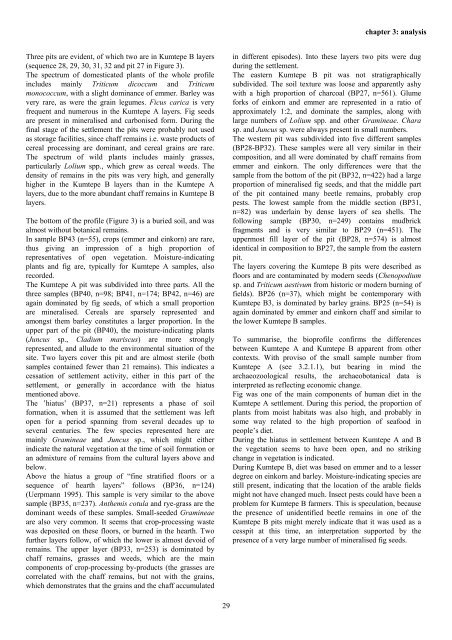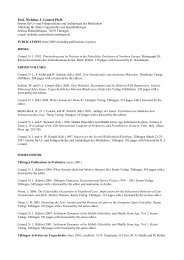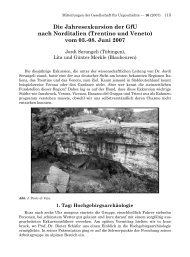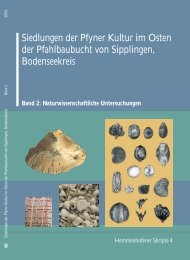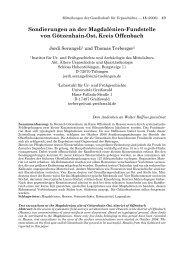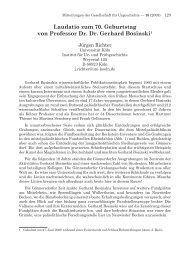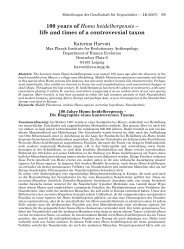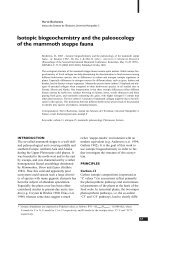bronze age environment and economy in the troad - Universität ...
bronze age environment and economy in the troad - Universität ...
bronze age environment and economy in the troad - Universität ...
Create successful ePaper yourself
Turn your PDF publications into a flip-book with our unique Google optimized e-Paper software.
chapter 3: analysis<br />
Three pits are evident, of which two are <strong>in</strong> Kumtepe B layers<br />
(sequence 28, 29, 30, 31, 32 <strong>and</strong> pit 27 <strong>in</strong> Figure 3).<br />
The spectrum of domesticated plants of <strong>the</strong> whole profile<br />
<strong>in</strong>cludes ma<strong>in</strong>ly Triticum dicoccum <strong>and</strong> Triticum<br />
monococcum, with a slight dom<strong>in</strong>ance of emmer. Barley was<br />
very rare, as were <strong>the</strong> gra<strong>in</strong> legumes. Ficus carica is very<br />
frequent <strong>and</strong> numerous <strong>in</strong> <strong>the</strong> Kumtepe A layers. Fig seeds<br />
are present <strong>in</strong> m<strong>in</strong>eralised <strong>and</strong> carbonised form. Dur<strong>in</strong>g <strong>the</strong><br />
f<strong>in</strong>al st<strong>age</strong> of <strong>the</strong> settlement <strong>the</strong> pits were probably not used<br />
as stor<strong>age</strong> facilities, s<strong>in</strong>ce chaff rema<strong>in</strong>s i.e. waste products of<br />
cereal process<strong>in</strong>g are dom<strong>in</strong>ant, <strong>and</strong> cereal gra<strong>in</strong>s are rare.<br />
The spectrum of wild plants <strong>in</strong>cludes ma<strong>in</strong>ly grasses,<br />
particularly Lolium spp., which grew as cereal weeds. The<br />
density of rema<strong>in</strong>s <strong>in</strong> <strong>the</strong> pits was very high, <strong>and</strong> generally<br />
higher <strong>in</strong> <strong>the</strong> Kumtepe B layers than <strong>in</strong> <strong>the</strong> Kumtepe A<br />
layers, due to <strong>the</strong> more abundant chaff rema<strong>in</strong>s <strong>in</strong> Kumtepe B<br />
layers.<br />
The bottom of <strong>the</strong> profile (Figure 3) is a buried soil, <strong>and</strong> was<br />
almost without botanical rema<strong>in</strong>s.<br />
In sample BP43 (n=55), crops (emmer <strong>and</strong> e<strong>in</strong>korn) are rare,<br />
thus giv<strong>in</strong>g an impression of a high proportion of<br />
representatives of open vegetation. Moisture-<strong>in</strong>dicat<strong>in</strong>g<br />
plants <strong>and</strong> fig are, typically for Kumtepe A samples, also<br />
recorded.<br />
The Kumtepe A pit was subdivided <strong>in</strong>to three parts. All <strong>the</strong><br />
three samples (BP40, n=98; BP41, n=174; BP42, n=46) are<br />
aga<strong>in</strong> dom<strong>in</strong>ated by fig seeds, of which a small proportion<br />
are m<strong>in</strong>eralised. Cereals are sparsely represented <strong>and</strong><br />
amongst <strong>the</strong>m barley constitutes a larger proportion. In <strong>the</strong><br />
upper part of <strong>the</strong> pit (BP40), <strong>the</strong> moisture-<strong>in</strong>dicat<strong>in</strong>g plants<br />
(Juncus sp., Cladium mariscus) are more strongly<br />
represented, <strong>and</strong> allude to <strong>the</strong> <strong>environment</strong>al situation of <strong>the</strong><br />
site. Two layers cover this pit <strong>and</strong> are almost sterile (both<br />
samples conta<strong>in</strong>ed fewer than 21 rema<strong>in</strong>s). This <strong>in</strong>dicates a<br />
cessation of settlement activity, ei<strong>the</strong>r <strong>in</strong> this part of <strong>the</strong><br />
settlement, or generally <strong>in</strong> accordance with <strong>the</strong> hiatus<br />
mentioned above.<br />
The ‛hiatus’ (BP37, n=21) represents a phase of soil<br />
formation, when it is assumed that <strong>the</strong> settlement was left<br />
open for a period spann<strong>in</strong>g from several decades up to<br />
several centuries. The few species represented here are<br />
ma<strong>in</strong>ly Gram<strong>in</strong>eae <strong>and</strong> Juncus sp., which might ei<strong>the</strong>r<br />
<strong>in</strong>dicate <strong>the</strong> natural vegetation at <strong>the</strong> time of soil formation or<br />
an admixture of rema<strong>in</strong>s from <strong>the</strong> cultural layers above <strong>and</strong><br />
below.<br />
Above <strong>the</strong> hiatus a group of “f<strong>in</strong>e stratified floors or a<br />
sequence of hearth layers” follows (BP36, n=124)<br />
(Uerpmann 1995). This sample is very similar to <strong>the</strong> above<br />
sample (BP35, n=237). An<strong>the</strong>mis cotula <strong>and</strong> rye-grass are <strong>the</strong><br />
dom<strong>in</strong>ant weeds of <strong>the</strong>se samples. Small-seeded Gram<strong>in</strong>eae<br />
are also very common. It seems that crop-process<strong>in</strong>g waste<br />
was deposited on <strong>the</strong>se floors, or burned <strong>in</strong> <strong>the</strong> hearth. Two<br />
fur<strong>the</strong>r layers follow, of which <strong>the</strong> lower is almost devoid of<br />
rema<strong>in</strong>s. The upper layer (BP33, n=253) is dom<strong>in</strong>ated by<br />
chaff rema<strong>in</strong>s, grasses <strong>and</strong> weeds, which are <strong>the</strong> ma<strong>in</strong><br />
components of crop-process<strong>in</strong>g by-products (<strong>the</strong> grasses are<br />
correlated with <strong>the</strong> chaff rema<strong>in</strong>s, but not with <strong>the</strong> gra<strong>in</strong>s,<br />
which demonstrates that <strong>the</strong> gra<strong>in</strong>s <strong>and</strong> <strong>the</strong> chaff accumulated<br />
<strong>in</strong> different episodes). Into <strong>the</strong>se layers two pits were dug<br />
dur<strong>in</strong>g <strong>the</strong> settlement.<br />
The eastern Kumtepe B pit was not stratigraphically<br />
subdivided. The soil texture was loose <strong>and</strong> apparently ashy<br />
with a high proportion of charcoal (BP27, n=561). Glume<br />
forks of e<strong>in</strong>korn <strong>and</strong> emmer are represented <strong>in</strong> a ratio of<br />
approximately 1:2, <strong>and</strong> dom<strong>in</strong>ate <strong>the</strong> samples, along with<br />
large numbers of Lolium spp. <strong>and</strong> o<strong>the</strong>r Gram<strong>in</strong>eae. Chara<br />
sp. <strong>and</strong> Juncus sp. were always present <strong>in</strong> small numbers.<br />
The western pit was subdivided <strong>in</strong>to five different samples<br />
(BP28-BP32). These samples were all very similar <strong>in</strong> <strong>the</strong>ir<br />
composition, <strong>and</strong> all were dom<strong>in</strong>ated by chaff rema<strong>in</strong>s from<br />
emmer <strong>and</strong> e<strong>in</strong>korn. The only differences were that <strong>the</strong><br />
sample from <strong>the</strong> bottom of <strong>the</strong> pit (BP32, n=422) had a large<br />
proportion of m<strong>in</strong>eralised fig seeds, <strong>and</strong> that <strong>the</strong> middle part<br />
of <strong>the</strong> pit conta<strong>in</strong>ed many beetle rema<strong>in</strong>s, probably crop<br />
pests. The lowest sample from <strong>the</strong> middle section (BP31,<br />
n=82) was underla<strong>in</strong> by dense layers of sea shells. The<br />
follow<strong>in</strong>g sample (BP30, n=249) conta<strong>in</strong>s mudbrick<br />
fragments <strong>and</strong> is very similar to BP29 (n=451). The<br />
uppermost fill layer of <strong>the</strong> pit (BP28, n=574) is almost<br />
identical <strong>in</strong> composition to BP27, <strong>the</strong> sample from <strong>the</strong> eastern<br />
pit.<br />
The layers cover<strong>in</strong>g <strong>the</strong> Kumtepe B pits were described as<br />
floors <strong>and</strong> are contam<strong>in</strong>ated by modern seeds (Chenopodium<br />
sp. <strong>and</strong> Triticum aestivum from historic or modern burn<strong>in</strong>g of<br />
fields). BP26 (n=37), which might be contemporary with<br />
Kumtepe B3, is dom<strong>in</strong>ated by barley gra<strong>in</strong>s. BP25 (n=54) is<br />
aga<strong>in</strong> dom<strong>in</strong>ated by emmer <strong>and</strong> e<strong>in</strong>korn chaff <strong>and</strong> similar to<br />
<strong>the</strong> lower Kumtepe B samples.<br />
To summarise, <strong>the</strong> bioprofile confirms <strong>the</strong> differences<br />
between Kumtepe A <strong>and</strong> Kumtepe B apparent from o<strong>the</strong>r<br />
contexts. With proviso of <strong>the</strong> small sample number from<br />
Kumtepe A (see 3.2.1.1), but bear<strong>in</strong>g <strong>in</strong> m<strong>in</strong>d <strong>the</strong><br />
archaeozoological results, <strong>the</strong> archaeobotanical data is<br />
<strong>in</strong>terpreted as reflect<strong>in</strong>g economic change.<br />
Fig was one of <strong>the</strong> ma<strong>in</strong> components of human diet <strong>in</strong> <strong>the</strong><br />
Kumtepe A settlement. Dur<strong>in</strong>g this period, <strong>the</strong> proportion of<br />
plants from moist habitats was also high, <strong>and</strong> probably <strong>in</strong><br />
some way related to <strong>the</strong> high proportion of seafood <strong>in</strong><br />
people’s diet.<br />
Dur<strong>in</strong>g <strong>the</strong> hiatus <strong>in</strong> settlement between Kumtepe A <strong>and</strong> B<br />
<strong>the</strong> vegetation seems to have been open, <strong>and</strong> no strik<strong>in</strong>g<br />
change <strong>in</strong> vegetation is <strong>in</strong>dicated.<br />
Dur<strong>in</strong>g Kumtepe B, diet was based on emmer <strong>and</strong> to a lesser<br />
degree on e<strong>in</strong>korn <strong>and</strong> barley. Moisture-<strong>in</strong>dicat<strong>in</strong>g species are<br />
still present, <strong>in</strong>dicat<strong>in</strong>g that <strong>the</strong> location of <strong>the</strong> arable fields<br />
might not have changed much. Insect pests could have been a<br />
problem for Kumtepe B farmers. This is speculation, because<br />
<strong>the</strong> presence of unidentified beetle rema<strong>in</strong>s <strong>in</strong> one of <strong>the</strong><br />
Kumtepe B pits might merely <strong>in</strong>dicate that it was used as a<br />
cesspit at this time, an <strong>in</strong>terpretation supported by <strong>the</strong><br />
presence of a very large number of m<strong>in</strong>eralised fig seeds.<br />
29


